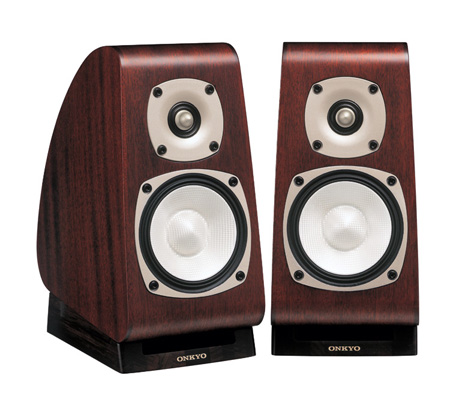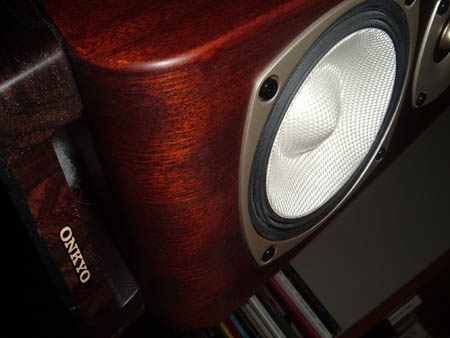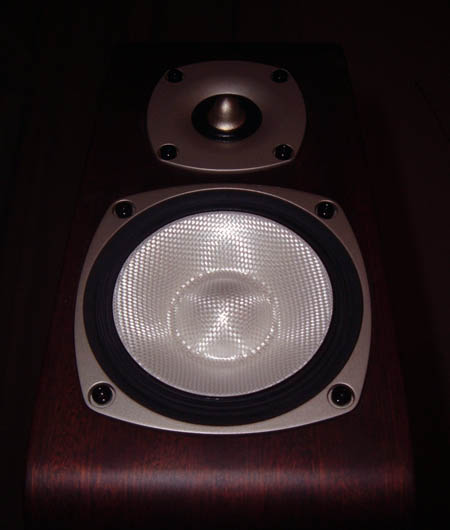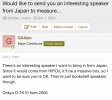Onkyo D-TK10 “Vintage” Speaker Review
(vs. JBL 708P)

TLDR? They’re great. No they’re not really vintage but they are the last flagship speaker from the pre-bankrupt Onkyo.
Eighteen years ago, Onkyo launched a statement pair of speakers, the D-TK10. Using an enclosure made by Takamine (the preferred guitar manufacturer of artists like Garth Brooks, Bruce Springsteen, Don Henley and Jon Bon Jovi) and all-custom Onkyo-manufactured drivers, the D-TK10 was sold at $2000/pair! Rather than towering behemoths that you’d associate with a flagship, these speakers only have 4” woofers and are a svelte 6.4 pounds!

There was some great technical marketing at the Japanese Onkyo website describing the work that went into the enclosure and speaker drivers.
Drivers
Enclosure
But no such detail was available in English.
 www.intl.onkyo.com
www.intl.onkyo.com
The advertised specifications are uninspiring and read like marketing hyperbole.
FEATURES
10 cm A-OMF Monocoque Diaphragm Woofer
3 cm Ring-Drive Tweeter
Supported by a Large Voice Coil
Takamine Acoustic Voicing Technology Construction
Aero Acoustic Drive for Powerful and Natural Sound
Network Circuit with High-Quality Parts
Gold-plated, Banana Plug-Compatible Speaker Posts
GENERAL SPECIFICATIONS
Max. input power: 200 W
Frequency response: 50 Hz–100 kHz
WHD: 133 x 276 x 220 mm
Weight: 2.9 kg
These speakers were also harshly criticized by Stereophile in a series of lengthy blog posts. The writer considered his DeVore Gibbon as a “gold standard” and the Onkyo’s were never reviewed formally by Stereophile. I am not aware of any measurements that have been published.
The DeVore line of speakers sound wonderful and look beautiful, but they are not accurate speakers. Still, the Stereophile writer had some strong opinions about this speaker.

 www.stereophile.com
www.stereophile.com

 www.stereophile.com
“The DeVores imparted the movement of the dance, gave the dance sway, and used the strong hand of love to neaten the overall presentation, adding life and intensity to the music. The Onkyos, it seemed, left things just the slightest bit loose and ragged. Just as I expected!”
www.stereophile.com
“The DeVores imparted the movement of the dance, gave the dance sway, and used the strong hand of love to neaten the overall presentation, adding life and intensity to the music. The Onkyos, it seemed, left things just the slightest bit loose and ragged. Just as I expected!”

 www.stereophile.com
“And the Onkyo D-TK10 loudspeakers, to me, are kind of like that. They're like little effects boxes. At the right time, with the right song, they can be absolutely wonderful. They are special speakers — specialty speakers, in fact — that are very good-looking and often lots of fun, that, while showing utter respect for the acoustic guitar and acoustic guitar music, in general, ultimately seem to lack respect for so many other types of instruments and music.”
www.stereophile.com
“And the Onkyo D-TK10 loudspeakers, to me, are kind of like that. They're like little effects boxes. At the right time, with the right song, they can be absolutely wonderful. They are special speakers — specialty speakers, in fact — that are very good-looking and often lots of fun, that, while showing utter respect for the acoustic guitar and acoustic guitar music, in general, ultimately seem to lack respect for so many other types of instruments and music.”
With those types of subjective comments, who in their right mind would want to try these speakers?
Me. That’s who. Statement products during an economic bubble? That’s the best time to find diamonds in the rough.
I found a nice deal on a used pair of speaker from a retailer in Japan. These are notoriously fragile and cannot be shipped in the absence of the original packaging unless you really trust the expertise of the seller. I reached out to @amirm to see if he had any time last year (October) to test these but unfortunately, Amir was pretty busy so I just had them shipped to me.

I spent the last several months listening to them subjectively and I found these speakers to sound great. They are sensitive to listening position, specifically speaker height, presumably due to the angled tweeter, but even without EQ or room correction, they do things well.
Since there were no good measurements out there, I decided to do some simple measurements and compare them in-room against the JBL 708P which has undergone extensive measurements here along with the recent 708i measurements that rekindled my interest in the comparison.
Test Configuration
Measured in my actual office. The listening/measuring position is about 8 feet away. Speakers are about 6-7 feet apart. Both left and right speakers were used for the REW sweep at listening position
As you see from the first photo, the speakers are in an Elfa wall-mounted shelving system which creates some extra bass from boundary gain.
The UMIK-1 microphone was directed toward speakers at ear height. The listening position is also against a wall.

Equipment
1) YellowTec PUC2 Lite AES/EBU to JBL 708P
vs.
2) Korg DS-DAC-10R unbalanced to Marantz PM-10 to Onkyo D-TK10
Volume matched in REW to 80 dB at listening position.
GREEN = JBL 708P
PURPLE = Onkyo D-TK10
First, 1/1 Octave Smoothing to show overall sound signature at the listening position between the two speakers

1/12 Octave Smoothing

C50 and C80 measurements for the Onkyo vs JBL.


Distortion at listening position for the Onkyo.

I then took some “nearfield” measurements about 1 foot away (single speaker) for the D-TK10 to reduce the room effects while still giving a reasonable integration of the two drivers. I did not move the speakers out of the Elfa shelf.

And the same 1 foot nearfield measurement with 1/1 smoothing

Finally, I tried an ultra near field with the microphone about 1 cm away from the driver.
This is at 1/48 octave smoothing.

Versus ZERO smoothing

And here is the distortion data


Subjective Impressions:
Bass shy, but an excellent speaker with a 4” woofer. There are certainly better options out there if you can fit bigger speakers, but in the super small speaker class, it’s excellent. I preferred the Onkyo’s to the SB Acoustics Micro-C and the XPL90’s (which are huge in comparison).

There is a hefty price premium incurred for “made in Japan, cabinet manufactured by Takamine” and a physics penalty for having something so small. These Onkyo’s are essentially audio jewelry, but it’s pretty clear that there is real engineering behind these speakers. Remember, these speakers are 18 years old!
Guitars sounded great on the Onkyo’s. I am sure a lot of this is sighted bias but acoustic guitars sounded more truthful on the Onkyo D-TK10 than the JBL 708P. If I had to provide an objective rationale for the guitar sound, it may be that the 240-500Hz range had relatively low distortion on the nearfield REW sweep which is suggested as an important range for guitars in this infographic:

The subjective testing used in the development of these speakers famously involved real Takamine guitars and the reproduction.
Conclusion:
These measurements are not high quality, quasi-anechoic spinoramas. There are clear limitations to vertical speaker placement which likely would easily be seen on a Klippel NFS.
The point to be made is that sighted bias works in both positive and negative directions. It can make you think budget brands sound worse than they really do. These Onkyo speakers are lightweight and have none of the physical heft you’d associate with a premium speaker. In 2005, Onkyo 7.1 AVRs started at just $300 so Onkyo was hardly considered a luxury audio jewelry brand in the US at that time (despite having a more favorable premium position in Japan with historic products like the Grand Integra line)
By any measure, the JBL 708P is a great speaker. One may prefer a Revel, KEF, Genelec, or Newman flagship over the JBL 708P but it would be a comparison between a great speaker and an “even better” speaker. That the Onkyo D-TK10 so closely matched the JBL 708P even at 1/12 octave smoothing in actual in-room measurements was a surprise to me.
Certainly these results should be sufficient to show that they are far from Stereophile’s description that they are a “little effects box.” These probably would have been truly state of the art 18 years ago.
What I am curious about is how today’s modern statement speakers designed in Japan perform.
Will someone send Amir a Diatone DS-4NB70 or Yamaha NS-5000?
(vs. JBL 708P)
TLDR? They’re great. No they’re not really vintage but they are the last flagship speaker from the pre-bankrupt Onkyo.
Eighteen years ago, Onkyo launched a statement pair of speakers, the D-TK10. Using an enclosure made by Takamine (the preferred guitar manufacturer of artists like Garth Brooks, Bruce Springsteen, Don Henley and Jon Bon Jovi) and all-custom Onkyo-manufactured drivers, the D-TK10 was sold at $2000/pair! Rather than towering behemoths that you’d associate with a flagship, these speakers only have 4” woofers and are a svelte 6.4 pounds!
There was some great technical marketing at the Japanese Onkyo website describing the work that went into the enclosure and speaker drivers.
Drivers
Enclosure
But no such detail was available in English.
D-TK10 | ONKYO Asia and Oceania Website
This page introduces Onkyo D-TK10, a 2-way bass reflex speakers.
The advertised specifications are uninspiring and read like marketing hyperbole.
FEATURES
10 cm A-OMF Monocoque Diaphragm Woofer
3 cm Ring-Drive Tweeter
Supported by a Large Voice Coil
Takamine Acoustic Voicing Technology Construction
Aero Acoustic Drive for Powerful and Natural Sound
Network Circuit with High-Quality Parts
Gold-plated, Banana Plug-Compatible Speaker Posts
GENERAL SPECIFICATIONS
Max. input power: 200 W
Frequency response: 50 Hz–100 kHz
WHD: 133 x 276 x 220 mm
Weight: 2.9 kg
These speakers were also harshly criticized by Stereophile in a series of lengthy blog posts. The writer considered his DeVore Gibbon as a “gold standard” and the Onkyo’s were never reviewed formally by Stereophile. I am not aware of any measurements that have been published.
The DeVore line of speakers sound wonderful and look beautiful, but they are not accurate speakers. Still, the Stereophile writer had some strong opinions about this speaker.

Nothing Unintentional

Not Exactly an Echo

Waxing Poetic About Mushrooms
With those types of subjective comments, who in their right mind would want to try these speakers?
Me. That’s who. Statement products during an economic bubble? That’s the best time to find diamonds in the rough.
I found a nice deal on a used pair of speaker from a retailer in Japan. These are notoriously fragile and cannot be shipped in the absence of the original packaging unless you really trust the expertise of the seller. I reached out to @amirm to see if he had any time last year (October) to test these but unfortunately, Amir was pretty busy so I just had them shipped to me.

I spent the last several months listening to them subjectively and I found these speakers to sound great. They are sensitive to listening position, specifically speaker height, presumably due to the angled tweeter, but even without EQ or room correction, they do things well.
Since there were no good measurements out there, I decided to do some simple measurements and compare them in-room against the JBL 708P which has undergone extensive measurements here along with the recent 708i measurements that rekindled my interest in the comparison.
Test Configuration
Measured in my actual office. The listening/measuring position is about 8 feet away. Speakers are about 6-7 feet apart. Both left and right speakers were used for the REW sweep at listening position
As you see from the first photo, the speakers are in an Elfa wall-mounted shelving system which creates some extra bass from boundary gain.
The UMIK-1 microphone was directed toward speakers at ear height. The listening position is also against a wall.
Equipment
1) YellowTec PUC2 Lite AES/EBU to JBL 708P
vs.
2) Korg DS-DAC-10R unbalanced to Marantz PM-10 to Onkyo D-TK10
Volume matched in REW to 80 dB at listening position.
GREEN = JBL 708P
PURPLE = Onkyo D-TK10
First, 1/1 Octave Smoothing to show overall sound signature at the listening position between the two speakers
1/12 Octave Smoothing
C50 and C80 measurements for the Onkyo vs JBL.
Distortion at listening position for the Onkyo.
I then took some “nearfield” measurements about 1 foot away (single speaker) for the D-TK10 to reduce the room effects while still giving a reasonable integration of the two drivers. I did not move the speakers out of the Elfa shelf.
And the same 1 foot nearfield measurement with 1/1 smoothing
Finally, I tried an ultra near field with the microphone about 1 cm away from the driver.
This is at 1/48 octave smoothing.
Versus ZERO smoothing
And here is the distortion data
Subjective Impressions:
Bass shy, but an excellent speaker with a 4” woofer. There are certainly better options out there if you can fit bigger speakers, but in the super small speaker class, it’s excellent. I preferred the Onkyo’s to the SB Acoustics Micro-C and the XPL90’s (which are huge in comparison).
There is a hefty price premium incurred for “made in Japan, cabinet manufactured by Takamine” and a physics penalty for having something so small. These Onkyo’s are essentially audio jewelry, but it’s pretty clear that there is real engineering behind these speakers. Remember, these speakers are 18 years old!
Guitars sounded great on the Onkyo’s. I am sure a lot of this is sighted bias but acoustic guitars sounded more truthful on the Onkyo D-TK10 than the JBL 708P. If I had to provide an objective rationale for the guitar sound, it may be that the 240-500Hz range had relatively low distortion on the nearfield REW sweep which is suggested as an important range for guitars in this infographic:
The subjective testing used in the development of these speakers famously involved real Takamine guitars and the reproduction.
Conclusion:
These measurements are not high quality, quasi-anechoic spinoramas. There are clear limitations to vertical speaker placement which likely would easily be seen on a Klippel NFS.
The point to be made is that sighted bias works in both positive and negative directions. It can make you think budget brands sound worse than they really do. These Onkyo speakers are lightweight and have none of the physical heft you’d associate with a premium speaker. In 2005, Onkyo 7.1 AVRs started at just $300 so Onkyo was hardly considered a luxury audio jewelry brand in the US at that time (despite having a more favorable premium position in Japan with historic products like the Grand Integra line)
By any measure, the JBL 708P is a great speaker. One may prefer a Revel, KEF, Genelec, or Newman flagship over the JBL 708P but it would be a comparison between a great speaker and an “even better” speaker. That the Onkyo D-TK10 so closely matched the JBL 708P even at 1/12 octave smoothing in actual in-room measurements was a surprise to me.
Certainly these results should be sufficient to show that they are far from Stereophile’s description that they are a “little effects box.” These probably would have been truly state of the art 18 years ago.
What I am curious about is how today’s modern statement speakers designed in Japan perform.
Will someone send Amir a Diatone DS-4NB70 or Yamaha NS-5000?
Last edited:


